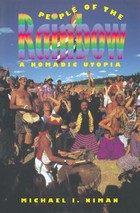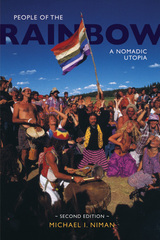
A fictional re-creation of a day in the life of a Rainbow character named Sunflower begins the book, illustrating events that might typically occur at an annual North American Rainbow Gathering. Using interviews with Rainbows, content analysis of media reports, participant observation, and scrutiny of government documents relating to the group, Niman presents a complex picture of the Family and its relationship to mainstream culture—called "Babylon" by the Rainbows. Niman also looks at internal contradictions within the Family and examines members' problematic relationship with Native Americans, whose culture and spiritual beliefs they have appropriated.
The nomadic nature of the Rainbow Family has long exasperated the U.S. government--especially the Forest Service--and has baffled the media. Niman places the Rainbow Family's gatherings in a historical context by framing the group's activities in terms of the long tradition of intentional communities and utopian experimentation within the United States. Concluding with reflections on the successes and limitations of the Rainbow movement, People of the Rainbow provides an extensive ethnography of this intriguing subculture and provides fresh insights into the ongoing legacy of utopian communalism.
The Author: Michael I. Niman is an adjunct assistant professor of American studies at the State University of New York at Buffalo and a lecturer in the communication department at Buffalo State College.

Since 1972 the Rainbow Family of Living Light, a loosely organized and anarchistic nomadic community, has been holding large gatherings in remote forests to pray for world peace and create a model of a functioning utopian society. Michael I. Niman’s People of the Rainbow, originally published in 1997, was the first comprehensive study of this countercultural group and its eclectic philosophy of environmentalism, feminism, peace activism, group sharing, libertarianism, and consensus government. It is a book yet to be superseded.
This second edition of Niman’s compelling and insightful work brings the Rainbow story up to date with a new introduction and two extensive new epilogues. While the big annual Rainbow “Gatherings” have drawn fewer numbers in recent years, Niman notes, the Rainbow ethos has in many ways migrated to the mainstream, as Rainbow notions about alternative medicine and environmental sustainability, for example, have gathered wider acceptance and influenced the national dialogue. Meanwhile, Rainbow movements in other regions, from Eastern Europe and the Middle East to Asia and Australia, are thriving.
In addition to addressing changes within the Rainbow Family and its complex relationship
to “Babylon” (what Rainbows call mainstream culture), the book’s new material explores the growing harassment Rainbows now face from U.S. law enforcement agencies—
especially those associated with the National Forest Service. As Niman contends, this particular saga of a U.S. bureaucracy at war with its own citizens is a subplot in the larger—and disturbing—story of how the relationship between Americans and their government has changed during the first decade of the twenty-first century.
In its nuanced portrait of an intriguing subculture, its successes, and its limitations, People of the Rainbow remains a significant contribution to the study of utopian communities in the United States and their ongoing legacy.
Michael I. Niman is a professor of journalism and media studies in the Communication Department at Buffalo State College in New York.
For additional resources related to this new edition, see http://buffalostate.edu/peopleoftherainbow.
READERS
Browse our collection.
PUBLISHERS
See BiblioVault's publisher services.
STUDENT SERVICES
Files for college accessibility offices.
UChicago Accessibility Resources
home | accessibility | search | about | contact us
BiblioVault ® 2001 - 2024
The University of Chicago Press









